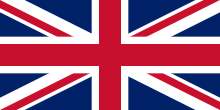Flag of Botswana
 | |
| Use | National flag |
|---|---|
| Proportion | 2:3 |
| Adopted | 30 September 1966 |
| Design | A light blue field cut horizontally in the centre by a black stripe with a thin white frame. |
The national flag of Botswana (Setswana: folaga ya Botswana) consists of a sky blue field cut horizontally in the centre by a black stripe with a thin white frame. Adopted in 1966 to replace the Union Jack, it has been the flag of the Republic of Botswana since the country gained independence that year. It is one of the few African flags that utilises neither the colours of the Pan-Africanist movement nor the colours of the country's leading political party.
Design[edit]

The Republic of Botswana has a rectangular flag with a 2:3 ratio.[1] Race is a very important feature of the flag.[2] It was designed in order to contrast with the South African flag at the time when apartheid was in effect.[3] The black band with the white frame has two meanings. They represent the harmony and cooperation between the people of different races who live in Botswana, as well as the racial diversity of the country.[1][4]
The blue is associated with the sky, and water which is scarce.[3] The country's motto, Pula, means water, rain, and the life that is derived from it.[1][4]
History[edit]

In 1885, Botswana became a protectorate of the United Kingdom within its colonial empire, under the name of the Bechuanaland Protectorate. This occurred after the leaders of the Tswana people negotiated with the British to offer them protection from the Boers, who were invading their lands from the neighbouring South African Republic.[5] Bechuanaland gained independence from Britain in 1966, and the new nation was renamed to Botswana.[4] The new flag was first hoisted at midnight on 30 September 1966, the day Botswana became an independent country.[6]
Preceding to its independence, the country did not have its own flag. It was designed to be distinct from the flag of South Africa, due to the country’s apartheid system. It is one of the few African flags that do not use the Pan-African colors or the colors of the flag of the dominant political party.[1] From 1885 to 1966, Botswana's flag was the Union Jack.[7] Under British rule, there was also no official flag, coat of arms, or badge, though there was a seal.[8]
Protocol[edit]
You need permission from the government to fly the flag.[7] A formal request must be sent to the Permanent Secretary to the President of Botswana.[9] It is recommended to not let the flag touch the floor, and make sure it remains upright at all times. It is also recommended to follow the tradition of hoisting it at dawn and lowering it at dusk. The blue band should be placed at the top with the black band in the middle, and the white band at the bottom when displaying the flag vertically. The guidelines also state to lower the flag to half staff to symbolize mourning or respect. If a flag gets damaged, there should be a burning ceremony. If burning is not an option, then it is recommended to "dispose of the flag respectfully."[10]
References[edit]
- ^ a b c d DK 2014, p. 146.
- ^ Kgalemang 2020, p. 257.
- ^ a b Kgalemang 2020, p. 261.
- ^ a b c Smith 2018.
- ^ The Editors of Encyclopædia Britannica.
- ^ Paine 1966.
- ^ a b Flagmakers, p. 1.
- ^ Flagmakers, p. 2.
- ^ Use of National Emblems.
- ^ National Flag Etiquette and Protocol.
Citations[edit]
- DK (19 May 2014). Complete Flags of the World: The Ultimate Pocket Guide. DK. ISBN 978-1-4654-3405-0.
- Smith, Whitney (13 November 2018). "Flag of Botswana". Britannica. Archived from the original on 27 February 2024. Retrieved 18 June 2024.
- Kgalemang, Malebogo (2020). "Ethnic Reasoning and the Making of the Nation of Botswana" (PDF). Alternation Special (36 ed.). doi:10.29086/2519-5476/2020/sp36a11. eISSN 2519-5476. ISSN 1023-1757. Archived (PDF) from the original on 10 July 2024.
- "Flag of Botswana - A Brief History" (PDF). Flagmakers. Archived (PDF) from the original on 13 July 2024. Retrieved 2 July 2024.
- "Use of National Emblems". Government of Botswana. Archived from the original on 5 March 2024. Retrieved 12 July 2024.
- "History of Botswana". The Editors of Encyclopædia Britannica. Britannica. Archived from the original on 15 May 2024. Retrieved 13 July 2024.
{{cite web}}: CS1 maint: others (link) - Paine, David J. (29 September 1966). "New nation raises flag". The Leader-Post. Regina. Associated Press. Archived from the original on 23 June 2023. Retrieved 5 June 2013.
- "Flag of Botswana in 2024 § National Flag Etiquette and Protocol". RJ Travel Agency. 2024. Archived from the original on 13 July 2024. Retrieved 13 July 2024.
